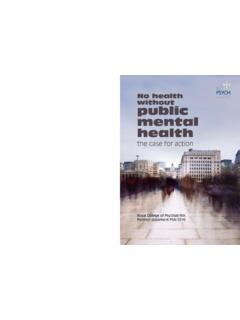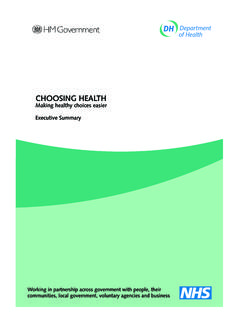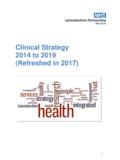Transcription of Closing the health inequalities gap : an …
1 Closing the health inequalities Gap: an international perspective Written by: Iain K Crombie Linda Irvine Lawrence Elliott Hilary Wallace The WHO Regional Office for Europe is one of six regional offices throughout the world, each with its own programme geared to the particular health problems of the countries it serves. The European Region embraces some 870 million people living in an area stretching from Greenland in the north and the Mediterranean in the south to the Pacific shores of the Russian Federation. The European programme of WHO therefore concentrates both on the problems associated with industrial and post-industrial society and on those faced by the emerging democracies of central and eastern Europe and the former USSR.
2 To ensure the widest possible availability of authoritative information and guidance on health matters, WHO secures broad international distribution of its publications and encourages their translation and adaptation. By helping to promote and protect health and prevent and control disease, WHO s books contribute to achieving the Organization s principal objective the attainment by all people of the highest possible level of health . WHO European Office for Investment for health and Development The WHO European Office for Investment for health and Development, which coordinated the activities leading to this publication, was set up by the WHO Regional Office for Europe, with cooperation and support from the Ministry of health and the Veneto Region of Italy.
3 One of its key responsibilities is to provide evidence on and act upon the social and economic determinants of health . The Office systematically reviews what is involved in drawing together the concepts, scientific evidence, technology and policy action necessary to achieve effective investment for the promotion of health and synergy between social, economic and health development. The Office fulfils two interrelated main functions: to monitor, review and systematize the policy implications of the social and economic determinants of population health ; and to provide services to help Member States in the WHO European Region increase their capacity to invest in health by addressing these policy implications and integrating them into the agenda for development.
4 Address requests about publications of the WHO Regional Office to: by e-mail (for copies of publications) (for permission to reproduce them) (for permission to translate them) by post Publications WHO Regional Office for Europe Scherfigsvej 8 DK-2100 Copenhagen , Denmark World health Organization 2005 All rights reserved.
5 The Regional Office for Europe of the World health Organization welcomes requests for permission to reproduce or translate its publications, in part or in full. The designations employed and the presentation of the material in this publication do not imply the expression of any opinion whatsoever on the part of the World health Organization concerning the legal status of any country, territory, city or area or of its authorities, or concerning the delimitation of its frontiers or boundaries. Where the designation country or area appears in the headings of tables, it covers countries, territories, cities, or areas.
6 Dotted lines on maps represent approximate border lines for which there may not yet be full agreement. The mention of specific companies or of certain manufacturers products does not imply that they are endorsed or recommended by the World health Organization in preference to others of a similar nature that are not mentioned. Errors and omissions excepted, the names of proprietary products are distinguished by initial capital letters. The World health Organization does not warrant that the information contained in this publication is complete and correct and shall not be liable for any damages incurred as a result of its use.
7 The views expressed by authors or editors do not necessarily represent the decisions or the stated policy of the World health Organization. English text editor: Barbara Zatlokal Cover art: Deanna Sirlin, Full (2002), Oil on Canvas ABSTRACT This report presents an analysis of official documents on government policies to tackle inequalities in health from 13 developedcountries. All countries recognize that health inequalities are caused by adverse socioeconomic and environmentalcircumstances. However they differ in their definitions of inequalities and in their approaches to tackling the problem.
8 Swedenand Northern Ireland have structured their overall public health policy to tackle the underlying determinants of inequalities in health . England is the only country with a separate comprehensive policy. Most countries also have policies on poverty, socialinclusion, and social justice. These are motivated by a concern for human rights and dignity and deal primarily with the underlying causes of health inequalities . While broadly setting the same overarching goal, policies on health inequalities showmany different features. Policymakers face two challenges: to ensure that strategies to tackle the macroenvironmental factors feature in policy on inequalities in health , and to ensure that health becomes a prominent issue in social justice policy.
9 Fewcountries have a coordinated approach to tackling inequalities in health . Keywords POVERTY; health SERVICES ACCESSIBILITY DELIVERY OF health CARE - organization and administration - trends SOCIAL JUSTICE; SOCIOECONOMIC FACTORS PUBLIC health ; health POLICY Table of contents Acknowledgements 2 Caveat 2 Executive summary 3 Introduction 6 Aims 9 Methods 9 Structure of policy on inequalities in health 11 Section 1 Documents on inequalities in health 11 Section 2 Description of inequalities in health 13 Section 3
10 Strategic approaches to tackling inequalities in health 21 Section 4 Evaluation of current policy 31 Section 5 Social inclusion and social justice policy 35 Synthesis 43 References 53 Annex 1 Bibliography of documents on inequalities in health 61 Annex 2 English Government s programme of work to tackle health inequalities 74 2 Acknowledgements The authors are grateful to NHS Heath Scotland for commissioning and funding this work. They would like to thank Dr Laurence Gruer, Jackie Willis, Jill Muirie and Dr Erica Wimbush for their support.
















